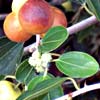Christ's Thorn Jujube is a dense thorny tree of tropical-Sudanese origin. The fruit is edible, but not high quality. In Arabic the tree is called by different names (sidar, dom, and in the Sinai also nabak). The name sidar has penetrated into the slang of the settlers, and the history of the settlement is accompanied by speaking about efforts to clear the “sidars”. The name “dom” has stuck mainly to the fruits – “doms”. Some make the mistake and call the fruit of the Crataegus by this name (its correct Arabic name is za’arur).
Two species of Ziziphus meet in Israel: Ziziphus spina-christi whose origin is tropical-Sudanese, in warm and humid landscapes, and arrived in Israel from the south, and Ziziphus lotus, whose origin is European and arrived from the north. Ziziphus spina-christi of the Sudanese origin, is found mainly in the warm valleys and oases of Israel. It even “deliberates” whether to shed leaves in winter, since in its countries of origin there is no cold winter. Here too it usually grows as an evergreen tree, and preserves its green leaves throughout the year. However, under extreme conditions, in cold areas or during an especially cold winter, it sheds most of its leaves. It is thought that the species arrived in Israel only during the pre-historic era (more precisely, during the Chalcolithic period, approximately 6000 years ago).
The tree is very thorny. Each leaf grows a pair of stipules at its base, which turn into hard thorns, one straight and the other hooked. The zigzag branches are very dense.
The leaf is dentate, ovate. Unlike common dicot leaf, it has three parallel midveins. Trees that become established in suitable places and are not felled reach a great size and age. In Israel, there are individuals with a height of 10 meters and a very broad trunk and large crown, which are several hundred years old. The largest tree in Israel, which is found at Ein Hatzeva, has been dated to around 800 years, and is the oldest tree known in Israel.
In the stories of the early Jewish settlement in the valleys of the northern part of Israel, the “sidar” is known as a stubborn enemy, which the farmers struggled to eradicate.
In some environments, such as the foothills of the Golan Heights, Ziziphus spina-christi creates a savanna-like landscape, together with Ziziphus lotus, Quercus boissieri, Pistacia atlantica and Styrax officinalis.
The main blooming occurs from March to October, but blooming may also occur during other months. The flowers are small and arranged in racemes. They are bisexual, green-yellowish, and not easily seen from a distance. However, they secrete a large amount of nectar which draws many insects, especially honey bees. A complex mechanism of alternate ripening of male and female parts of the flower ensures cross pollination.
The fruit is round, 1-2 cm diameter, brown-yellowish when ripe. It contains a large stone in the center, which is surrounded by a dry and fleshy pulp. The fruit is edible, but not very tasty – poor people’s food.
The wood was used for producing crude tools.
The genus contains 100 species, 3 of which grow in Israel.
Written by Mike Livne






